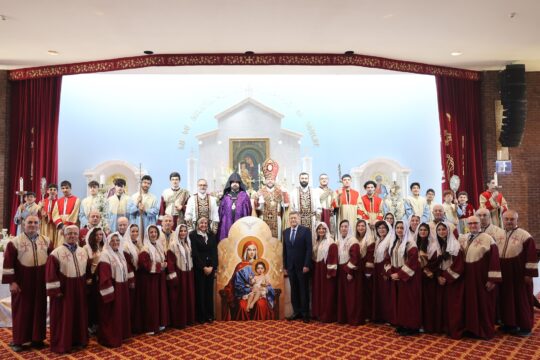 My holy pilgrimage to Jerusalem in 2012 was a journey of two different themes: a rediscovery and renewal of my faith in God, and a rediscovery of my family history.
My holy pilgrimage to Jerusalem in 2012 was a journey of two different themes: a rediscovery and renewal of my faith in God, and a rediscovery of my family history.
I grew up hearing colorful and dramatic stories of my mother’s childhood in Jerusalem, particularly her experiences in the Armenian quarter of the old city, about my grandmother’s stay at the Vaspuragan orphanage as a survivor of the Armenian genocide, about my grandfather’s job as a policeman under the British mandate, his humble food shop across the street from Saint James, and my late uncle’s carvings in stone on the convent walls.
 I also grew up as an Armenian Christian, studying the bible and reading the history of Christ.
I also grew up as an Armenian Christian, studying the bible and reading the history of Christ.
But both of these things, faith and family history, were always just abstractions: stories in books and images from photographs. To actually go to the place itself, where it happened, to experience it first hand, to feel it and smell it and eat its food, is something entirely different. It is a transcendent experience.
These two themes, faith and family, merged together beautifully during my visit to Jerusalem, the holiest place in the world for people of Christian faith. My parents and I joined the Canadian Armenian Pilgrimage Group from Montreal, headed by his eminence, Bishop Bagrat Galstanian, and organized by Sossi Manougian. We toured the holy sites as humble pilgrims, from the Jordan river where Christ was baptized, to the Sea of Galilee where he did much of his preaching, to his birthplace in Bethlehem, to the sacred site of the annunciation in Nazareth, the location of the sermon on the mount, to the city of Jerusalem itself and the great Armenian church of Saint James within the walls of the Armenian quarter. At the Church of the Holy Sepulchre, we witnessed the miracle of the holy fire being passed from pilgrim to pilgrim, and the inspiring spectacle of the Easter services by the Armenian clergy. Some of the most moving and spiritual aspects of the trip, however, were the simple quiet moments of prayer and biblical readings from our clergy and our group in these historical places, where Christ himself walked, preached and performed his miracles.
 The trip was also an opportunity to explore my family history, and this made my pilgrimage an especially personal one. I visited the Holy Cross Monastery, also known as the Vaspuragan orphanage. This was where my grandmother and her brother, merely children at the time, were mercifully sheltered after being forcibly marched through the Syrian Desert during the genocide. In the old city, I saw the police station where my grandfather worked as a police officer, and I was able to move one step closer to his past as Fedayee, fighting the Turks during the genocide.
The trip was also an opportunity to explore my family history, and this made my pilgrimage an especially personal one. I visited the Holy Cross Monastery, also known as the Vaspuragan orphanage. This was where my grandmother and her brother, merely children at the time, were mercifully sheltered after being forcibly marched through the Syrian Desert during the genocide. In the old city, I saw the police station where my grandfather worked as a police officer, and I was able to move one step closer to his past as Fedayee, fighting the Turks during the genocide.
I walked through the humble stone room in the convent where my grandparents, uncle, and mother lived after taking refuge during the war, along with hundreds of other displaced Armenian families. My uncle Setrak, who tragically passed away in 2004, carved images in the convent stone as a boy. Remarkably, after 56 years, these images were still there, as fresh as the day they were made. We met several of my mother’s childhood friends, still living in the convent. We met other Armenians who make the convent their home today. They were generous and hospitable, offering us coffee, refreshments, and good conversation. They didn’t treat us as strangers, but welcomed us as friends. I witnessed, firsthand, why the Armenian quarter, the church, and the convent are still a vital part of our Armenian cultural identity, and why we as Armenians need to visit this place often, and, by doing so, help to ensure its survival.
For the Christian, and particularly the Armenian, a pilgrimage to the Holy Land and the Armenian quarter is a voyage that must be taken, not because it is mandatory, but because it is so inspiring. It is a journey to the very source of Christianity, to the very place where “the Word was made flesh and dwelt among us”. Visiting this sacred spiritual destination is truly the experience of a lifetime. (- Raffi Kondy)


